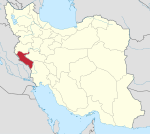Hejdandasht Rural District
Nowadays, Hejdandasht Rural District has become a topic of great importance and interest in modern society. With the advancement of technology and constant changes in the world, Hejdandasht Rural District has captured the attention of millions of people around the world. From its impact on everyday life to its influence on culture and the economy, Hejdandasht Rural District has established itself as a relevant topic worthy of analysis today. In this article, we will explore in depth the different aspects related to Hejdandasht Rural District, providing a comprehensive overview that allows us to understand its importance today.
Hejdandasht Rural District
Persian: دهستان هجداندشت | |
|---|---|
| Coordinates: 33°26′22″N 46°08′58″E / 33.43944°N 46.14944°E[1] | |
| Country | Iran |
| Province | Ilam |
| County | Mehran |
| District | Salehabad |
| Capital | Rika |
| Population (2016)[2] | |
• Total | 1,778 |
| Time zone | UTC+3:30 (IRST) |
Hejdandasht Rural District (Persian: دهستان هجداندشت) is in Salehabad District of Mehran County, Ilam province, Iran.[3] Its capital is the village of Rika.[4]
Demographics
Population
At the time of the 2006 National Census, the rural district's population was 1,925 in 396 households.[5] There were 1,648 inhabitants in 407 households at the following census of 2011.[6] The 2016 census measured the population of the rural district as 1,778 in 510 households. The most populous of its 42 villages was Golan, with 986 people.[2]
See also
References
- ^ OpenStreetMap contributors (24 November 2024). "Hejdandasht Rural District (Mehran County)" (Map). OpenStreetMap (in Persian). Retrieved 24 November 2024.
- ^ a b Census of the Islamic Republic of Iran, 1395 (2016): Ilam Province. amar.org.ir (Report) (in Persian). The Statistical Center of Iran. Archived from the original (Excel) on 1 November 2020. Retrieved 19 December 2022.
- ^ Habibi, Hassan (c. 2024) . Approval of the organization and chain of citizenship of the elements and units of the national divisions of Ilam province, centered in the city of Ilam. lamtakam.com (Report) (in Persian). Ministry of the Interior, Defense Political Commission of the Government Council. Proposal 3233.1.5.53; Letter 93808-907; Notification 83348/T132K. Archived from the original on 8 February 2024. Retrieved 8 February 2024 – via Lam ta Kam.
- ^ Mousavi, Mirhossein (6 January 2015) . Creation and establishment of five rural districts in Mehran County under Ilam province. rc.majlis.ir (Report) (in Persian). Ministry of the Interior, Board of Ministers. Proposal 53.1.12995; Notification 118418/T916. Archived from the original on 26 December 2016. Retrieved 7 February 2024 – via Islamic Parliament Research Center.
- ^ Census of the Islamic Republic of Iran, 1385 (2006): Ilam Province. amar.org.ir (Report) (in Persian). The Statistical Center of Iran. Archived from the original (Excel) on 20 September 2011. Retrieved 25 September 2022.
- ^ Census of the Islamic Republic of Iran, 1390 (2011): Ilam Province. irandataportal.syr.edu (Report) (in Persian). The Statistical Center of Iran. Archived from the original (Excel) on 17 January 2023. Retrieved 19 December 2022 – via Iran Data Portal, Syracuse University.


